The Fraunhofer Institute first announced their Tabola OLED lighting panels back in October 2010, with plans to release them in Q1 2011. We haven't heard anything since (and I assumed the project was scrapped) - but last week I got a nice surprise in the mail: three sample panels (two transparent, one structured). The Fraunhofer are now producing sample panels and have actually started to ship these cool transparent Tabola OLEDs to customers now - which makes these the first transparent OLED lighting panels on the market. Read on for our hands-on review.
About the Tabola panels
Fraunhofer are offering Tabola panels in three sizes: a large rectangle (the T157, 150x76 mm), a small square (the T77, 75x76 mm) and a small rectangle (the T37, 75x31 mm). The panels themselves are either transparent, opaque or structured (i.e. opaque panels with a custom logo or lettering). The opaque panels are available in a colored or white (3200K) versions. The panels are not very efficient (the transparent white modules's efficacy is about 12 to 18 lm/W, depending on the module size) and they feature a typical CRI of 90, and an average transmittance of 45% (at 550 nm).
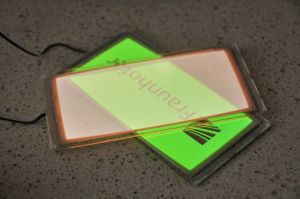 | 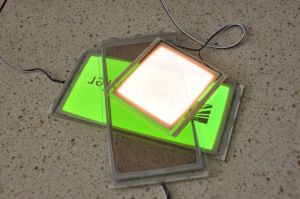 |
The Fraunhofer Institute has no intention of turning this into a real product - they just want interested people to be able to get the latest transparent OLED technology to play with, integrate it into sample applications, etc. The Tabola panels are made at COMEDD on their Gen-2 (370x470 mm) pilot production line.
What's in the box
The box (which is rather basic, no fancy stuff here like Philips does now) includes the OLED panels (3 in my case), a battery driver with a dimmer and an AC adapter and driver. Because the green emitter is more efficient than the white one, it is driven with a lower current - and can be run from the battery driver. You can also drive it with a DC and then it'll be brighter - but it will not last long in such a setup...
 | 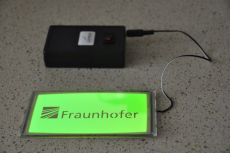 | 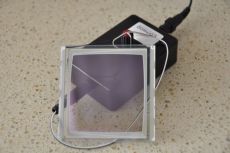 |
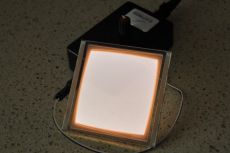 | 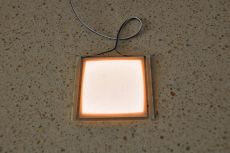 | 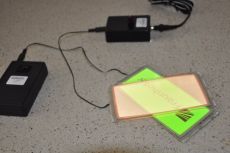 |
The panels themselves are pretty, and somehow feels very different to other OLED lighting panels I've held - they seem not to be 100% straight because of the inside curved bezel or conducting lines. This is interesting and quite pretty, but I'm guessing that if you actually want to use these in an installation it can be annoying.
Hands on
The transparent panels are indeed transparent, which is rather cool. It feels like a regular piece of glass, just a little dark. When turned on the panels are still transparent (but seem less so because they emit light). It's quite amazing at first, but after a minute or two you get used to it.
The Tabola panels are very light, and funnily felt lighter than the Philips Lumiblade tall rectangle to me, even though the Lumiblade is much smaller. It turns out that the Tabola weighs 42 grams and the Lumiblade weighs 23 grams. I guess both panels are simply too light for me to actually make a real comparison...
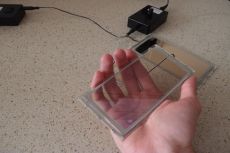 | 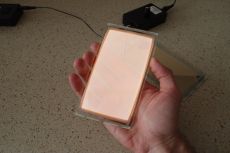 | 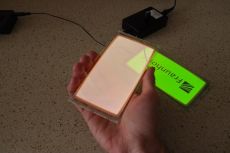 |
The structured OLED is actually very impressive. When turned off it's like a mirror and it's difficult to spot the structure. When turned on it emits a beautiful green light and the structure is striking. When I demonstrate the new panels to some people they actually said the structured OLED is more impressive than the transparent ones. Mostly because they don't think a transparent OLED is useful. After hearing of applications such as car windshields, lamps embedded in mirrors or windows it started to make sense though.
Compared to other panels
While these are the first transparent OLED panels available, there are many other companies offering "regular" OLED panels. There's not much sense in comparing a transparent panel to a non-transparent one, but still here's a video showing the new Tabola panels together with a couple of Philips Lumiblades and a large panel from Lumiotec:
And here are a few photos showing all those OLED panels together:
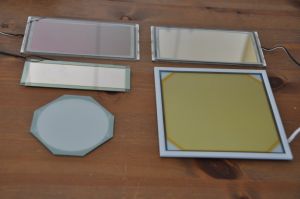 | 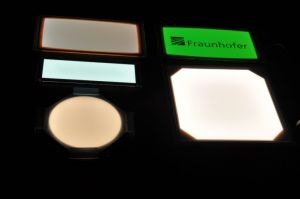 |
Want your own Tabola panels?
The Fraunhofer do not have a proper web shop, but if you're interested in getting your own panels, you should contact them directly. The pricing isn't public yet, but are in the range of a "few hundred euro" per panel. If you want a structured OLED you have to buy at least five, and there's an extra charge for the custom structure.
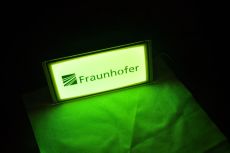 | 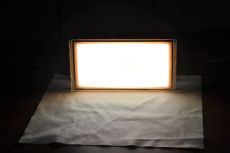 | 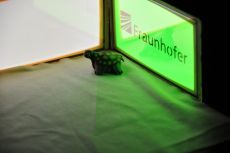 |
Want to learn more about OLED lighting?
be sure to read our OLED lighting introduction article. If you want more in-depth information, check out The OLED Handbook, our comprehensive guide to OLED technology, industry and market for OLED lighting and displays.

